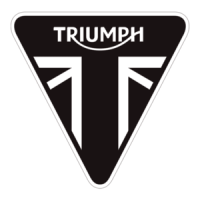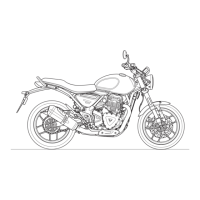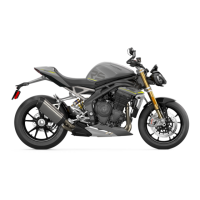Do you have a question about the Triumph Speedmaster and is the answer not in the manual?
Defines symbols for important information and safety warnings.
Explains specific warning labels found on the motorcycle.
Covers safe riding practices, fatigue, impairment, and speed.
Recommends essential protective gear for rider and passenger.
Details the placement of warning labels on the motorcycle.
Identifies major parts of the motorcycle with diagrams.
Explains the location of VIN and engine serial numbers.
Covers ignition switch operation, keys, and steering lock.
Explains dashboard gauges, indicators, and warning lights.
Details controls on right and left handlebars.
Information on fuel grade, tank, and safe refuelling procedures.
Guidance on breaking in a new motorcycle for optimal performance.
Step-by-step guide to starting and stopping the motorcycle engine.
Explains clutch use and gear shifting for smooth operation.
Covers proper braking methods and emergency braking.
Guidelines for safe parking on various surfaces and inclines.
Hazards and precautions for adding accessories or loads.
How to safely carry a passenger and their responsibilities.
Overview of recommended maintenance schedules and procedures.
Procedures for checking, changing engine oil, and replacing the filter.
Inspecting and adjusting the throttle grip and cables.
Checking and adjusting clutch lever free play.
Procedures for chain lubrication, adjustment, and wear inspection.
Inspecting brake pads, fluid levels, and switches.
Adjusting rear suspension and inspecting tyres.
Care, charging, and replacement procedures for the battery.
Fuse identification, replacement, and bulb replacement.
Steps for preparing the motorcycle for storage and retrieval.
Key performance metrics and physical dimensions of the motorcycle.
Details on the engine, fuel type, and system components.
Specifications for the transmission, gear ratios, and tyre types.
Specifications for electricals, tightening torques, and fluids/lubricants.
Defines symbols for important information and safety warnings.
Explains specific warning labels found on the motorcycle.
Covers safe riding practices, fatigue, impairment, and speed.
Recommends essential protective gear for rider and passenger.
Details the placement of warning labels on the motorcycle.
Identifies major parts of the motorcycle with diagrams.
Explains the location of VIN and engine serial numbers.
Covers ignition switch operation, keys, and steering lock.
Explains dashboard gauges, indicators, and warning lights.
Details controls on right and left handlebars.
Information on fuel grade, tank, and safe refuelling procedures.
Guidance on breaking in a new motorcycle for optimal performance.
Step-by-step guide to starting and stopping the motorcycle engine.
Explains clutch use and gear shifting for smooth operation.
Covers proper braking methods and emergency braking.
Guidelines for safe parking on various surfaces and inclines.
Hazards and precautions for adding accessories or loads.
How to safely carry a passenger and their responsibilities.
Overview of recommended maintenance schedules and procedures.
Procedures for checking, changing engine oil, and replacing the filter.
Inspecting and adjusting the throttle grip and cables.
Checking and adjusting clutch lever free play.
Procedures for chain lubrication, adjustment, and wear inspection.
Inspecting brake pads, fluid levels, and switches.
Adjusting rear suspension and inspecting tyres.
Care, charging, and replacement procedures for the battery.
Fuse identification, replacement, and bulb replacement.
Steps for preparing the motorcycle for storage and retrieval.
Key performance metrics and physical dimensions of the motorcycle.
Details on the engine, fuel type, and system components.
Specifications for the transmission, gear ratios, and tyre types.
Specifications for electricals, tightening torques, and fluids/lubricants.
| Displacement | 1200 cc |
|---|---|
| Bore x Stroke | 97.6 mm x 80 mm |
| Compression Ratio | 10.0:1 |
| Max Torque | 106 Nm @ 4, 000 rpm |
| Fuel System | Multipoint sequential electronic fuel injection |
| Clutch | Wet, multi-plate assist clutch |
| Gearbox | 6-speed |
| Rear Tyre | 150/80 R16 |
| Engine Type | Liquid-cooled, 8-valve, SOHC, 270° |
| Max Power | 76.9 bhp (57.4 kW) @ 6, 100 rpm |
| Exhaust | 2-into-2 exhaust system with twin silencers |
| Frame | Tubular steel |
| Rear Suspension | Twin shocks, adjustable preload |
| Front Brake | Twin 310mm discs, 2-piston floating calipers |
| Rear Brake | Single 255mm disc, 2-piston floating caliper |
| Front Wheel | 32-spoke |
| Rear Wheel | 32-spoke |
| Tank Capacity | 12 L |












